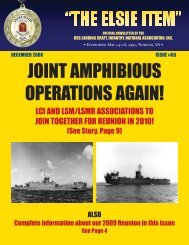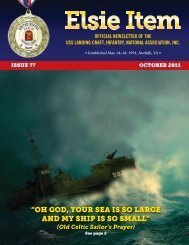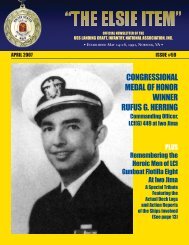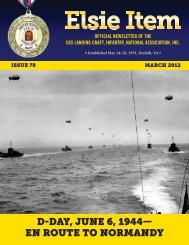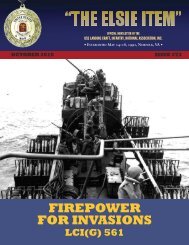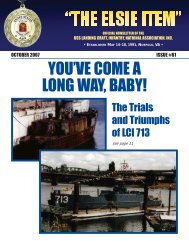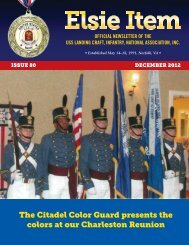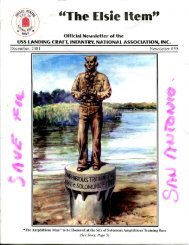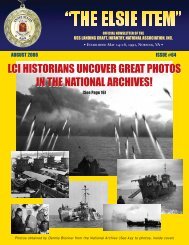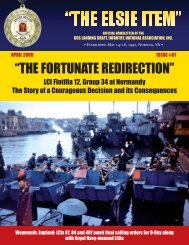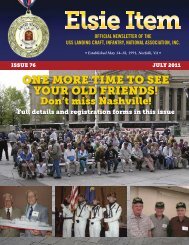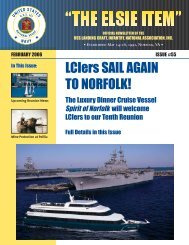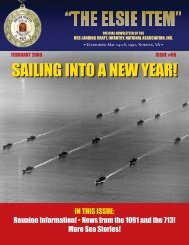elsie item issue 57 - USS Landing Craft Infantry National Association
elsie item issue 57 - USS Landing Craft Infantry National Association
elsie item issue 57 - USS Landing Craft Infantry National Association
You also want an ePaper? Increase the reach of your titles
YUMPU automatically turns print PDFs into web optimized ePapers that Google loves.
A History of LCI Flotilla 22ByJim TalbertLCI 618Jim Talbert, Chairman of the Board of the <strong>USS</strong> LCI<strong>National</strong> <strong>Association</strong>, served as CommunicationsSupervisor on the staff of the Commander ofFlotilla 22. Because there were so many LCIsinvolved with this flotilla, Jim thought there werebe a good many of you who would find hisaccount of interest. We're grateful to Jim for sharingthis with usIs your ship listed here? If so, then this is part ofyour history.Ship No. 62 - 63 - 328 - 333 - 334 - 335 - 3<strong>57</strong> -358 - 359 - 360 - 433 - 434 - 435 - 436 - 443 - 444- 445 - 446 - 518 - 519 - 614 - 615 - 616 - 617 -618 - 619 - 688 - 689 - 690 - 776 - 777 - 985 - 986- 987 - 1032 - 1033.The first 19 of these ships were from the oldFlotilla 5. The first flagship was the 433 underthe command of Commander Mc D. Smith, thenthe 618 under the command of CommanderMarion M. Byrd and finally the 690 under thecommand of Commander Philip Porter.Our ships were the smallest sea worthy ships ofWWII. They had a Hull length of 158 feet, awidth of 24 feet and a draft of 4 feet forward and6 feet aft. They had a cruising range of 4000miles at a standard speed of 12 knots.The basic purpose of this small ship was to carryinfantry troops for a short distance and landthem on hostile beaches all over the world. EachShip could carry a maximum of a company of200 fully armed combat ready troops.However, some of these small ships were convertedto do other tasks. Some were converted togun ships, that carried 3 - 40mm single mountguns and 4 - 20mm single mount guns. Otherswere converted to rocket ships that could fire 504- 4.5 “ rockets at a range of 1000 yards. Still otherswere converted to mortar firing ships. Theseconversions were made to support the landing ofthe <strong>Infantry</strong>. Flotilla 22 was made up of 36 ofthese small ships, with 3 Groups of 12 each. Theywere designated as Groups 64, 65 and 66.Flotilla 22 Staff, for most of WWII was billetedaboard the <strong>USS</strong> LCI 618(FF). The flotilla wasformed in early August, 1944, and was commandedby Commander McD Smith, as a spin offof old Flotilla 5, which was broken up.For the first month of operation we wereassigned to transporting troops and supplies ofthe 6th US Army for reinforcement in and aroundFinschhafen, Aitape and Biak Island and the NewGuinea area. However, on September 16th wegot our first taste of what it was all about withthe invasion of Morotai Island just west of NewGuinea.The LCI Unit of Task Group 77.4 comprised of LCI's433(Flag), 435, 360, 446, 519, 334, 445, 444, 359,3<strong>57</strong>, 443, 63, 328, 333, 436,335, 447, 429, 364and 62.The convoy proceeded, without incident, west toMorotai Island. At 0532 when the Task Group hadreached a point just south of the southern tip ofMorotai Island, orders were received by radiofrom the Task Group Commander in U.S.S.Nicholas (DD 449) directing the LCI's to leave theconvoy and proceed independently.At 0540 antiaircraft fire was observed comingfrom shore installations on the DehegilaPeninsula and smoke was seen rising from the22




